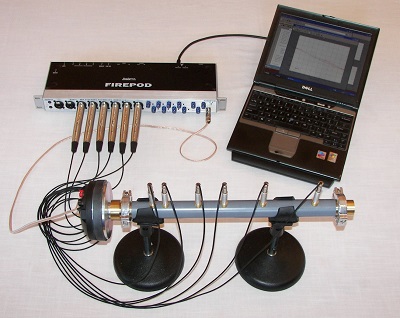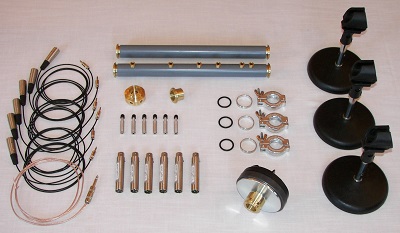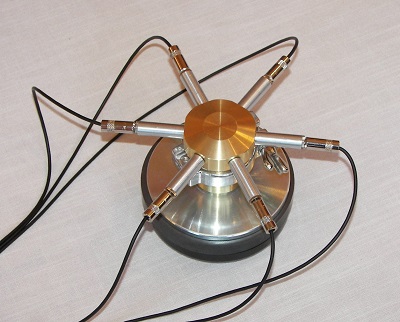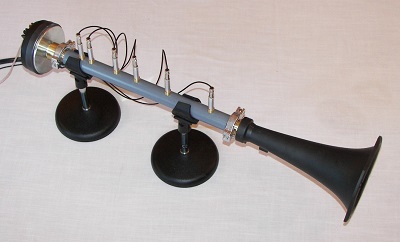Price Research Group
Quantum Dynamics with a side of Acoustics
at the University of Colorado Boulder
Acoustic Vector Network Analyzer
Introduction
The Acousic Vector Network Analyzer (AVNA) is essentially a loudspeaker connected to a tube with a set of microphones that measure the acoustic pressure of waves traveling inside the tube. If the speaker is driven sinusoidally at a frequency below about 8 kHz, only one mode can propagate in the tube, so the sound field is completely described by the amplitude and phase of one right-going and one left-going plane wave.
 The microphones, together with a data acquisition system and some Matlab software, can measure the right- and left-going wave amplitudes and phases as a function of the excitation frequency. At the undriven end of the tube you can attach a test object (a horn, an absorber, a resonant cavity, another transmission line…) and measure the reflection of sound off the object. If the object responds linearly, its behaviour is completely described by the reflection coefficient, the complex ratio of the reflected to incident wave amplitudes. The software can make a plot of the reflection coefficient versus frequency, among other things.
The microphones, together with a data acquisition system and some Matlab software, can measure the right- and left-going wave amplitudes and phases as a function of the excitation frequency. At the undriven end of the tube you can attach a test object (a horn, an absorber, a resonant cavity, another transmission line…) and measure the reflection of sound off the object. If the object responds linearly, its behaviour is completely described by the reflection coefficient, the complex ratio of the reflected to incident wave amplitudes. The software can make a plot of the reflection coefficient versus frequency, among other things.
With this system you can explore many elementary and some not-so-elementary aspects of sound propagation in a waveguide. Basic concepts include standing versus running waves, wave impedance, termination impedance, waves represented by complex amplitudes, and the reflection coefficient. More advanced applications include radiation from horns and horn driving impedance, resonant cavities (including cavity coupling and cavity perturbations), acoustic absorbers, coupled electromechanical systems, and gas physics. Most of these topics have applications to other areas of physics outside of acoutics. This page describes the AVNA system primarily as an educational tool, but we also use this hardware and software in our research on flute acoustics. If you are doing the AVNA experiment in PHYS4430 or PHYS5430 at CU, instructions for the lab are here.

The AVNA is a modular set of parts with a standard connection flange for joining sections of 25 mm ID waveguide. ISO-25 (KF-25) vacuum flange clamps are used, but the flanges have been modified with an insert ring that maintains a smooth inner bore and coaxial alignment. To keep the cost down, we use a commercial digitizer that is sold for home recording use. These units, which are available from several vendors for less than $500, provide simultaneous 12-bit, 44.1 kHz sampling on eight or more channels, along with several D/A output channels.

We also use inexpensive electret microphone cells. This kind of microphone is not usually thought to be stable enough for measurement applications, but in our situation stable absolute calibration is not important. We find that they can be used to measure reflection coefficients with an accuracy of a few percent if they are regularly calibrated for relative sensitivity and phase at the same set of frequencies that will be used for the reflection measurements. We do this using the calibration cell shown at the left. The cell's six-fold symmetry ensures that the same acoustic amplitude and phase is applied to each microphone during calibration.

Some components are commercially available for 25 mm or one-inch ID acoustic waveguide, such as the horn shown at left and the compression driver we use as a sound source. If you have experience with electronic waveguides, you might might expect to be able to buy other standard components such as attenuators, terminators and directional couplers. However, these are not readily available for acoustic waveguides. Even the research literature offers very few examples of such components.
Student Projects
Matthew Wittmann's undergraduate honors thesis: Resonant modes of a cylindrical cavity compared to analytical and finite-element calculations.
Daniel McKinnon's undergraduate honors thesis: Our first experiments on the recorder air-jet amplifier. See this page for more recent work along the same lines.
Justin Lawson's REU report and his Matlab code: Reflection coefficient of an open end and a horn compared to finite element calculations.
William Johnston's REU slides: William's project in the summer of 2007 demonstrated that electret cells have sufficient stability if they are calibrated appropriately.
AVNA Documentation
The AVNA User's Guide: How to set up and run the system, example experiments, suggestions for projects. Also includes documentation for the Matlab software.
Acoustic Waveguides: Physics background for the Acoustic Vector Network Analyzer and its applications.
AVNA Lab 1.0: Matlab code for the AVNA system, as described in the User's Guide.
Schematics for our electret buffer amplifiers.
Mechanical drawings of the AVNA components.
